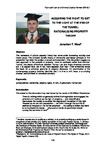Acquiring the Right to Get to the Light at the End of the Tunnel: Rationalising Property Theory
| dc.contributor.author | Ward, Jonathan T | |
| dc.date.accessioned | 2017-04-03T08:53:49Z | |
| dc.date.accessioned | 2017-04-11T11:37:20Z | |
| dc.date.available | 2017-04-03T08:53:49Z | |
| dc.date.available | 2017-04-11T11:37:20Z | |
| dc.date.issued | 2016 | |
| dc.identifier.citation |
Ward, J.T. (2016) 'Acquiring the Right to Get to the Light at the End of the Tunnel: Rationalising Property Theory', Plymouth Law and Criminal Justice Review, 8, pp. 131-155. Available at: https://pearl.plymouth.ac.uk/handle/10026.1/9027 | en_US |
| dc.identifier.issn | 2054-149X | |
| dc.identifier.uri | http://hdl.handle.net/10026.1/9027 | |
| dc.description.abstract |
The framework of private property theory has come under increasing scrutiny over recent years. The orthodox bundle theory of ownership and labour principle of first acquisition has been the subject of attack and scepticism. This discussion suggests a new approach to the analysis of property, focus on synthesis rather than contrast. Further, the classic differences between Roman Law and Anglo-American common law, it is argued here, are in fact more apparent than real – their similarities reveal the basis for a universal grammar in property discourse. An examination of the contemporary property theories identifies that it is time to shift focus to a unifying concept and synthesis of canonical concepts. | en_US |
| dc.language.iso | en | en_US |
| dc.publisher | University of Plymouth | |
| dc.rights | Attribution 4.0 International (CC BY 4.0) | * |
| dc.rights.uri | https://creativecommons.org/licenses/by/4.0/ | * |
| dc.subject | Jurisprudence | en_US |
| dc.subject | ownership | en_US |
| dc.subject | property rights | en_US |
| dc.subject | in rem | en_US |
| dc.subject | in personam | en_US |
| dc.subject | Roman law | en_US |
| dc.title | Acquiring the Right to Get to the Light at the End of the Tunnel: Rationalising Property Theory | en_US |
| dc.type | Article | en_US |
| dc.type | Article | |
| plymouth.volume | 8 | |
| plymouth.journal | The Plymouth Law & Criminal Justice Review |



